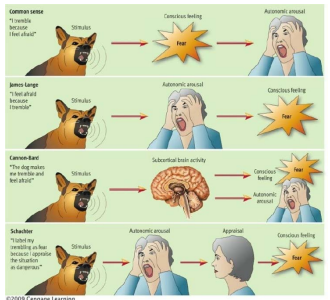[HCI] 2. Human 2
Thinking
- Reasoning(추론) - 앞 뒤를 생각해서 이건 이렇게 될 것 같아! 처럼 추측하는 행위
- deduction, induction, abduction
- Problem solving - reasoning과는 달리 답이 없는 상태에서 답을 찾아내려고 하는 방식
Deductive Reasoning
- Deduction(연역): If A, then B
- Derive logically necessary conclusion from given premises(전제).
- e.g. If it is Friday then she will go to work
- It is Friday
- Therefore she will go to work.
- Logical conclusion not necessarily true:
- e.g. If it is raining then the ground is dry
- It is raining
- Therefore the ground is dry
- Derive logically necessary conclusion from given premises(전제).
- 꼭 옳다는 것을 의미하는 것은 아님(잘못될 수도 있음)
- 전제가 틀려있을 수도 있다.
Deduction (cont.)
-
When truth and logical validity clash …
- 조건이 불충분할 수 있다.
- e.g. Some people are babies
- Some babies cry
- Inference(추론) - Some people cry
- some 때문에 전체적으로 맞는 경우가 아니라 부분적으로 맞는 경우가 된다.(불충분)
Correct?
-
People bring world knowledge to bear
Inductive Reasoning(귀납적 추론)
- Induction: Generalizing from previous cases to learn about new ones
- Generalize from cases seen to cases unseen
- case들을 모아 일반화시키는 방식
- e.g. All elephants we have seen have trunks, therefore all elephants have trunks.
- Generalize from cases seen to cases unseen
- Unreliable:
- Can only prove false, not true – checking all elephants (?)
- 하나만 잘못된 것을 찾으면 바로 틀린 논제가 되어버림
- 그래서 이를 증명하려면 모든 경우를 확인해야 함.
- … but useful!
- 하지만 효율적임!
- Humans not good at using negative evidence
- e.g. Wason’s cards.
Wason’s cards

If a card has a vowel(모음) on one side, it has an even number on the other
Is this true?
How many cards do you need to turn over to find out?
…. and which cards?
- E를 뒤집으면 반드시 짝수가 있어야 하지만 4를 뒤집었을 땐 모음이 없어도 된다.(조건을 잘 읽으면…)
- 그런데 사람들은 4뒤에는 모음이 있어야 된다고 착각
- 이것이 negative evidence!
- 조건문이 앞에 것이 뒤에 것을 보장하지만 뒤에 것이 앞에 것을 보장하지 않는다.
Abductive Reasoning(가설 유도적 추론)
- Abduction: Reasoning from a fact back to the action or state that caused it
- Reasoning from event to cause
- e.g. Sam drives fast when drunk.
- If I see Sam driving fast, assume drunk.
- Reasoning from event to cause
- Unreliable:
- Can lead to false explanations(가설이기 때문에)
정말 모르겠을 때 추론하는 방법
Reasoning
- Deductive reasoning is valid
- Deductive inference guarantees if the premises are true so it the conclusion
- Inductive and abductive reasoning are unreliable
- Cannot guarantee true conclusions even with true premises(전제)
- Inductive reasoning: conclusion merely likely
- Abductive reasoning: taking your best shot
- Deductive reasoning is limited to application of rules to examples
- Inductive and abductive reasoning are important for generating hypotheses
Reasoning (cont.)
- Humans rely on inductive and abductive inference, as well as deduction
- Humans regulate inherent unreliability of these reasoning modes
- Using contextual knowledge
- Using belief revision
- Computers rely primarily on deductive inference
- Although some AI techniques use induction and abduction
Reasoning to Problem-Solving
- Where reasoning involves inference about a familiar problem domain
- Problem solving refers to the ability to design solutions to problems in unfamiliar problem domains
- Humans use at least three types of problem-solving techniques
- Heuristics (해 보고 판단하는 것)
- Analogy(유추) and metaphor(비유)
- Learning
Problem-Solving Techniques
- Heuristics: using informed trial and error based on rules of thumb
- 사람이 대충 정해서 하겠다.(사바사)
- E.g. Chess openings (develop your pieces, gain control of the center of the board)
- Analogy and metaphor: adapting solutions from one problem domain to another
- E.g Object-orientation (treating software modules as physical objects)
- Learning: improving performance by acquiring skills over time with repeated exposure to a problem
- E.g. Multiply 1496 by 20
How Problem-Solving works
- Process of finding solution to unfamiliar task using knowledge
- Storage in LTM, then application of knowledge
- Observation:
- People are more heuristic than algorithmic - 사람들은 algorithmic보단 heuristic을 더 좋아함.
- Try a few quick shots rather than plan because resources are simply not available
- People often choose suboptimal strategies for low priority problems
- 우선순위가 낮다고 생각될 수록 대충함
- People learn better strategies with practice
- 연습하면 더 좋아짐
- People are more heuristic than algorithmic - 사람들은 algorithmic보단 heuristic을 더 좋아함.
- Several theories.
- Gestalt
- Problem Space Theory
- Analogy
- Skill Acquisition
Gestalt Theory
- means “unified whole”
- Problem solving both productive and reproductive
- Productive draws on insight and restructuring of problem
- Attractive but not enough evidence to explain `insight’ etc.
- Move away from behaviourism and led towards information processing theories
- 행동주의에서 벗어나 정보처리 이론으로 이어집니다.
- Principles:
- Similarity
- Continuation
- Closure
- Proximity (근처에 있는 것일수록)
- Figure and Ground(foreground, background에 따라서)
- 전혀 상관없어 보이는 도형일지라도 모이면 무슨 의미인지 알 수 있다.

Problem Space Theory
- Problem space comprises problem states
- 문제를 단계적으로 해석
- state들을 내가 원하는 쪽으로 몰고 감.
- Problem-solving involves generating states using legal operators
- Heuristics may be employed in order to select operators
- e.g. means-ends analysis
- 수단을 통해 목적을 달성하도록 하는 것
- Operates within human information processing system
- e.g. STM limits etc.
- short term memory가 관여
- Largely applied to problem-solving in well-defined areas
- e.g. puzzles rather than knowledge intensive areas
Other Problem Solving Issues
- Analogy
- Analogical mapping:
- Novel problems in new domain?
- Use knowledge of similar problem from similar domain
- Analogical mapping difficult if domains are semantically different
- 의미적으로 다르면 비유적인 mapping 어려움
- Analogical mapping:
- Skill Acquisition
- Skilled activity characterized by chunking (묶는 행위)
- Lot of information is chunked to optimize STM
- Conceptual rather than superficial grouping of problems
- 문제의 표면적인 그룹화가 아닌 개념적 그룹화
- Information is structured more effectively
Mental Models
- How do we understand how the world works?
- 우리는 세상이 어떻게 돌아가는지 어떻게 이해하는가
- More than simple memory (단순한 메모리 공간 이상이다.)
- Includes expectations of behaviour
- 행동의 기대를 포함
- I throw a ball at my friend, and she catches it
- How did I know how hard to throw it?
- How did she know where to stand to catch it?
- We have an understanding of the mechanics of the world
- How objects interact, the relationships between them
- 물체가 어떻게 상호작용하고 있는지 그 메카닉 적인 부분을 잘 이해하고 있음.
What is a mental model?
- A cognitive structure that encodes how an aspect of the world operates
- Includes information about which object classes interact with which other classes
- Also includes information about how objects interact, and how interactions change properties
- Malleable(온순한) structures which are strengthened by successful application
- successful application으로 강화된 온순한 구조
Mental model example
The circle is above and to the right of the square
- We can ask questions about this situation
- Which object is to the left?
- Which object is at the bottom?
- Would the circle balance on the square?
- By creating a mental model, these questions are simple to answer
- Add in knowledge we already have
- You can simply ‘see’ the answer
How we use mental models
- We use mental models to generate predictions
- Predict where the ball will land
- Expertise is generally associated with mental models closer to reality
- An expert cricket(크리켓;운동) player understands ball physics better
- But mental models are always unconscious (‘knowing’ doesn’t help)
- Mental models are not based on accurate physics
- Can lead to incorrect predictions
- Based on experience, etc.
- Change as they are used
- 실제로 그렇지 않더라도 경험에 의해서 그렇게 생각이 되어진다.
Expanding mental models
- HCI researchers have expanded the idea
- Includes a user’s understanding of the workings of a computing device
- Expectations of menu structures, where files are stored, etc.
- In HCI understanding user’s mental models is important
- Understand how learning a system works
- Reduce stress/workload by supporting user’s mental models
- Tailor systems to fit how users perceive the system
Mental models and user-interfaces(UI)
- Any interface requires a mental model to use
- What to expect when typing, clicking, etc
- How to interpret the consequences of actions (e.g. link new window with clicking of the icon)
- Mental models are important when interface has little feedback
- Difficult to recognize results
- Few cues to evaluate the new state of the system
- Problems with impoverished(궁핍한) devices
Errors and Mental Models
-
Types of Error
-
Slips
-
Right intention, but failed to do it right
- Causes: poor physical skill, inattention(부주의) etc.
- 어떻게 하는지 알고 있는지 잘못누름
-
Change to aspect of skilled behaviour can cause slip
- 잘못누른 것이기 때문에 설명으로 해결되지 않음
-
-
-
Mistakes
- Wrong intention
- Cause: incorrect understanding (잘못된 이해)
- humans create mental models to explain behaviour.
- if wrong (different from actual system) errors can occur
- 처음부터 이해를 잘못한 것.
Emotion
- Various theories of how emotion works
- James-Lange: emotion is our interpretation of a physiological response to a stimuli
- 자극에 대해서 신체적 반응이 나타내는 것
- Cannon: emotion is a psychological response to a stimuli
- 심리적으로 나타나는 것
- Schachter-Singer: emotion is the result of our evaluation of our physiological responses, in the light of the whole situation we are in
- 개가 짖으면 어떤 반응이 보여질 텐데 나중에 가서 ‘아 이게 공포였구나’를 느끼는 것이 감정이다.(?)
- James-Lange: emotion is our interpretation of a physiological response to a stimuli
- Emotion clearly involves both cognitive and physical responses to stimuli

Emotion (cont.)
- The biological response to physical stimuli is called affect
- Affect influences how we respond to situations
- positive -> creative problem-solving
- negative -> narrow thinking
- “Negative affect can make it harder to do even easy tasks; positive affect can make it easier to do difficult tasks” - Donald Norman
- Implications for interface design
- Stress will increase the difficulty of problem-solving
- Relaxed users will be more forgiving(용서) of shortcomings(결점) in design
- Aesthetically pleasing and rewarding interfaces will increase positive affect
- interface의 효율 뿐 아니라 보기 좋은 것 -> positive affect를 주기 때문에
positive affect는 중요하구나!
Individual Differences
- Long term
- sex, physical and intellectual abilities
- Short term
- effect of stress or fatigue(피로도; 지속적인)
- Changing
- age
Ask yourself: will design decision exclude section of user population?
Psychology vs. Design of Interactive System
- Some direct applications
- e.g. blue acuity is poor
- blue should not be used for important detail
- e.g. blue acuity is poor
- 눈에 띄면서 자세한 걸 원하면 그린
- 눈에 확실히 띄게 하려면 레드
- 블루는 자세한 걸 나타날 때 맹점을 보임
- However, correct application generally requires understanding of context in psychology, and an understanding of specific experimental conditions
- A lot of knowledge has been distilled in
- guidelines
- cognitive models
- experimental and analytic evaluation techniques

댓글남기기